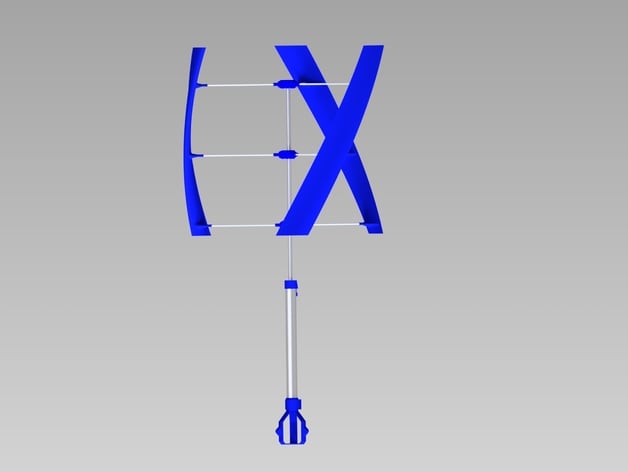
Darrieus VAWT - Wendel/S
thingiverse
Old plastic bottles pose a significant environmental threat in various regions around the world. These bottles are made from PET and are therefore non-biodegradable. The good news is that PET can be recycled relatively easily. Considering this issue, I designed a vertical-axis wind turbine for my master's thesis project. The requirements for this turbine were quite specific: Firstly, it had to be printable using a standard desktop 3D printer (in this case, a MakerBot 5th Generation). Secondly, all necessary parts should be available in developing countries. Thirdly, the cost had to be low. Fourthly, it had to be easy to repair. Finally, it needed to generate enough power to charge a smartphone. The turbine features three helical blades with an DU-06-W-200 profile developed by Delft University (1). Each blade consists of five elements and a top and bottom cover. To conserve materials, the parts are hollow and stiffened with struts and rips. The components are connected using notches, lips, and a wire rope (I used bowden cables from bicycles). A bike dynamo is utilized as an electrical power generator. The benefits of utilizing bicycle equipment lie in its low cost and wide availability across almost every point on the planet. A threaded rod (M16) serves as the shaft. However, finding a straight one can be challenging, but developing a prototype with it is relatively easy. To measure the rotational speed (which is directly proportional to the power output), I set up a Raspberry Pi with a hall sensor. Additional information will be provided soon, including: Power and wind measurements More details about blade parameters Building instructions A parts list More images and videos Possibly, the complete thesis in German (1) http://lr.home.tudelft.nl/fileadmin/Faculteit/LR/Organisatie/Afdelingen_en_Leerstoelen/Afdeling_AEWE/Aerodynamics/Contributor_Area/Secretary/M._Sc._theses/doc/2006_1_17.pdf Print Settings: Printer Brand: MakerBot Printer Model: MakerBot Replicator (5th Generation) Rafts: Not Required Supports: Yes Resolution: 0.2 mm Infill: 40% Notes: The thin part of the profiles warps easily. If you experience problems, use a raft or brim and apply two or three shells. Post-Printing: Benefits of Post-Processing: A smooth surface increases the turbine's performance. Several options are available to achieve this. Sanding is hazardous due to the thin walls. It is better to paint the parts with an epoxy resin and then sand them afterwards. The surface not only becomes smoother but also tougher.
With this file you will be able to print Darrieus VAWT - Wendel/S with your 3D printer. Click on the button and save the file on your computer to work, edit or customize your design. You can also find more 3D designs for printers on Darrieus VAWT - Wendel/S.
